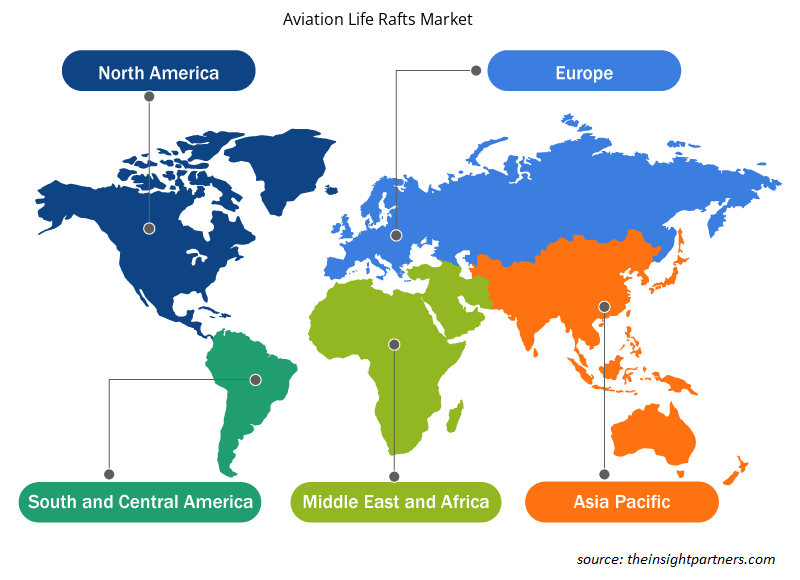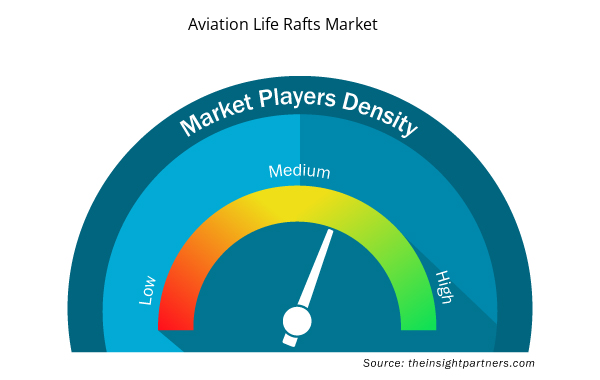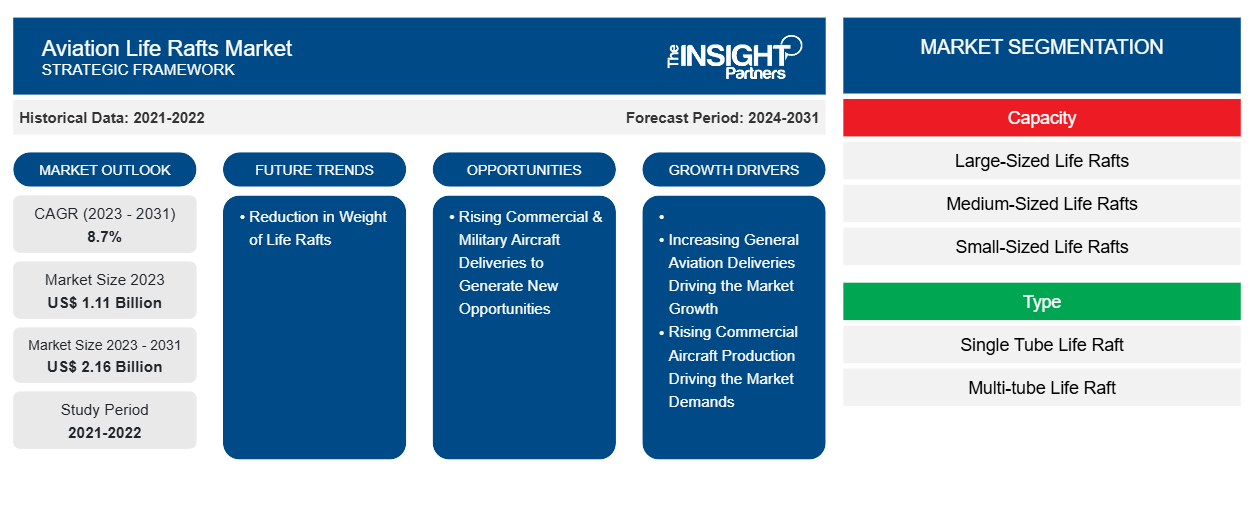航空救生筏市场规模预计将从 2023 年的 11.1 亿美元增至 2031 年的 21.6 亿美元。预计该市场在 2023-2031 年的复合年增长率为 8.7%。航空救生筏市场的参与者提供的产品使用寿命超过十年;然而,救生筏的使用寿命限制为三年。较短的使用寿命允许最终用户每三年安装一次新的救生筏,从而确保在任何水上着陆事故中救生筏顺利充气和进一步操作,从而使最终用户受益。
航空救生筏市场分析
航空救生筏市场的关键利益相关者是救生筏材料供应商、航空救生筏制造商和最终用户。由于飞机制造业的增长和政府投资,对航空救生筏的需求很高。各公司不断增加的研发计划进一步促进了全球航空航天市场的增长。在市场生态系统中,救生筏材料供应商提供与航空救生筏相关的各种材料。一些救生筏材料供应商如 Trellborg AB、ContiTech AG 等。救生筏制造商提供不同类型的救生筏,市场上的一些制造商包括 Collins Aerospace、Safran、Survitec Group Ltd. 等。制造商高度专注于通过提供创新的航空救生筏来扩大其客户群。航空救生筏市场的最终用户直接从制造商处采购这些救生筏。市场上的最终用户包括飞机制造商、军队和通用航空飞机运营商。
航空救生筏市场概况
航空救生筏的需求主要受以下一些因素驱动:
- 通用航空交付量增加推动市场增长
- 商用飞机产量增长推动市场需求
- 航空救生筏使用寿命较短
这些因素不断推动着不同地区航空救生筏市场的增长。航空救生筏的一些主要最终用户包括商用和军用飞机 OEM、通用航空和支线飞机 OEM 以及飞机 MRO 供应商。
定制此报告以满足您的需求
您可以免费定制任何报告,包括本报告的部分内容、国家级分析、Excel 数据包,以及为初创企业和大学提供优惠和折扣
- 获取此报告的关键市场趋势。这个免费样品将包括数据分析,从市场趋势到估计和预测。
航空救生筏市场驱动因素和机遇
通用航空交付量增加推动市场增长
通用航空飞机交付数量的增加可能会推动不同地区航空救生筏市场的增长。根据通用航空制造商协会 (GAMA) 的数据,2023 年,不同地区共交付了约 3,050 架通用航空飞机。与 2022 年相比,2023 年通用航空交付量增长了 9%。此外,每架通用航空飞机上至少有两个救生筏,均根据 FAA TSO-C70a 规范获得认证。另一方面,2023 年活塞发动机飞机的交付量增长了 11.8%(交付了 1,682 架);公务机的交付量有所增加,2023 年交付了 730 架,而 2022 年为 712 架。这些因素正在推动全球航空救生筏市场的增长。
商用和军用飞机交付量增加带来新机遇
商用飞机交付数量的增加是预测期内可能为市场供应商创造新机会的主要因素之一。未来 20 年内商用飞机的预期交付可能会为航空救生筏供应商在未来几年创造新的机会。根据几家航空业的消息来源,预计到 2042 年将交付超过 40,000 架新商用飞机。此外,军用飞机的预期采购是另一个可能在未来几年为救生筏制造商提供新机会的主要因素。俄罗斯-乌克兰、以色列-巴勒斯坦和以色列-伊朗等几个国家之间持续不断的冲突也支持了这一点,这些冲突引起了不同国家提高各自军事实力的意识。为此,不同国家已经向军用飞机制造商提供了多份合同,用于各种类型的飞机,包括战斗机、侦察机、货机和空中加油机。这些因素也推动了救生筏在军用飞机领域的部署。
航空救生筏市场报告细分分析
有助于得出航空救生筏市场分析的关键部分是容量、类型、应用和地理位置。
- 根据容量,市场细分为大型救生筏、中型救生筏、小型救生筏。大型救生筏部分在 2023 年占据了更大的市场份额。
- 根据类型,市场分为单管救生筏和多管救生筏。多管救生筏部分在 2023 年占据了最大的市场份额。
- 从应用方面来看,市场已细分为通用航空、军事/国防航空和商用航空。通用航空领域在 2023 年占据了市场主导地位。
航空救生筏市场份额按地区分析
航空救生筏市场报告的地理范围主要分为五个地区:北美、欧洲、亚太、中东和非洲、南美。
2023 年,北美占据了航空救生筏市场的主导地位,而亚太地区在预测期内可能会出现显着增长。美国在北美航空救生筏市场占有较大的市场份额。这主要是因为该国有几家航空救生筏制造商,即:EAM Worldwide、Life Support International, Inc.、Revere Survival Inc.、AVI Aviation 和 Collins Aerospace 等,这是该国航空救生筏增长的重要原因之一。此外,该国的军事开支是全球最高的,这支持了最大的军用飞机机队的发展,从而推动了美国市场的发展。此外,诺斯罗普·格鲁曼和雷神技术等主要通用航空飞机制造商的存在,要求在这些飞机上集成救生筏和疏散滑块。
航空救生筏市场区域洞察
Insight Partners 的分析师已详细解释了预测期内影响航空救生筏市场的区域趋势和因素。本节还讨论了北美、欧洲、亚太地区、中东和非洲以及南美和中美洲的航空救生筏市场细分和地理位置。

- 获取航空救生筏市场的区域特定数据
航空救生筏市场报告范围
| 报告属性 | 细节 |
|---|---|
| 2023 年的市场规模 | 11.1亿美元 |
| 2031 年市场规模 | 21.6亿美元 |
| 全球复合年增长率(2023 - 2031) | 8.7% |
| 史料 | 2021-2022 |
| 预测期 | 2024-2031 |
| 涵盖的领域 | 按容量
|
| 覆盖地区和国家 | 北美
|
| 市场领导者和主要公司简介 |
|
航空救生筏市场参与者密度:了解其对业务动态的影响
航空救生筏市场正在快速增长,这得益于终端用户需求的不断增长,而这些需求又源于消费者偏好的不断变化、技术进步以及对产品优势的认识不断提高等因素。随着需求的增加,企业正在扩大其产品范围,进行创新以满足消费者的需求,并利用新兴趋势,从而进一步推动市场增长。
市场参与者密度是指在特定市场或行业内运营的企业或公司的分布情况。它表明相对于给定市场空间的规模或总市场价值,有多少竞争对手(市场参与者)存在于该市场空间中。
在航空救生筏市场运营的主要公司有:
- EAM 全球
- 生命支持国际有限公司
- 崇敬生存公司
- 赛峰集团
- Survitec集团有限公司
- AVI 航空
免责声明:上面列出的公司没有按照任何特定顺序排列。

- 获取航空救生筏市场顶级关键参与者概述
航空救生筏市场新闻和最新发展
航空救生筏市场通过收集一级和二级研究后的定性和定量数据进行评估,其中包括重要的公司出版物、协会数据和数据库。以下是航空救生筏市场的发展和战略列表:
- 2023 年 7 月,AVI Survival Products 发布了新款 6 人可翻转救生筏。该产品配备手动启动、系绳触发的自充气系统,救生筏确保在需要时迅速做出反应。充气系统包括充满 N2/CO2 的复合气瓶、压力表和充气阀。此外,可翻转救生筏还配有带凹陷刀片设计的筏刀、环绕筏外部周边的救生索、登船后可竖起的顶篷、存放在阻燃袋中的抛绳和环、专门设计的两用海锚/筏手提箱、战略性定位的登船辅助工具、手动泵组件和综合设备套件。(来源:FCAH Aerospace,新闻稿/公司网站/通讯)
- 2022 年 3 月,Survitec 推出了一款“更小更轻的单座救生筏”(SSLR),以更好地装备军用快速喷气式飞机飞行员执行更具挑战性的任务或被迫从飞机上弹射出水面时。(来源:Comtek Advanced Structures Ltd,新闻稿/公司网站/通讯)
航空救生筏市场报告覆盖范围和交付成果
“航空救生筏市场规模和预测(2021-2031)”报告对以下领域进行了详细的市场分析:
- 范围内所有主要细分市场的全球、区域和国家层面的市场规模和预测
- 市场动态,如驱动因素、限制因素和关键机遇
- 未来的主要趋势
- 详细的波特五力分析
- 全球和区域市场分析涵盖关键市场趋势、主要参与者、法规和最新市场发展
- 行业格局和竞争分析,涵盖市场集中度、热点图分析、知名参与者和最新发展
- 带有 SWOT 分析的详细公司简介
- 历史分析(2 年)、基准年、预测(7 年)及复合年增长率
- PEST 和 SWOT 分析
- 市场规模价值/数量 - 全球、区域、国家
- 行业和竞争格局
- Excel 数据集


- Redistribution Layer Material Market
- Compounding Pharmacies Market
- Intradermal Injection Market
- Ketogenic Diet Market
- Lyophilization Services for Biopharmaceuticals Market
- Wheat Protein Market
- Molecular Diagnostics Market
- Thermal Energy Storage Market
- Latent TB Detection Market
- Underwater Connector Market

Report Coverage
Revenue forecast, Company Analysis, Industry landscape, Growth factors, and Trends

Segment Covered
This text is related
to segments covered.

Regional Scope
North America, Europe, Asia Pacific, Middle East & Africa, South & Central America

Country Scope
This text is related
to country scope.
Trends and growth analysis reports related to Aerospace and Defense : READ MORE..
The Insight Partners performs research in 4 major stages: Data Collection & Secondary Research, Primary Research, Data Analysis and Data Triangulation & Final Review.
- Data Collection and Secondary Research:
As a market research and consulting firm operating from a decade, we have published and advised several client across the globe. First step for any study will start with an assessment of currently available data and insights from existing reports. Further, historical and current market information is collected from Investor Presentations, Annual Reports, SEC Filings, etc., and other information related to company’s performance and market positioning are gathered from Paid Databases (Factiva, Hoovers, and Reuters) and various other publications available in public domain.
Several associations trade associates, technical forums, institutes, societies and organization are accessed to gain technical as well as market related insights through their publications such as research papers, blogs and press releases related to the studies are referred to get cues about the market. Further, white papers, journals, magazines, and other news articles published in last 3 years are scrutinized and analyzed to understand the current market trends.
- Primary Research:
The primarily interview analysis comprise of data obtained from industry participants interview and answers to survey questions gathered by in-house primary team.
For primary research, interviews are conducted with industry experts/CEOs/Marketing Managers/VPs/Subject Matter Experts from both demand and supply side to get a 360-degree view of the market. The primary team conducts several interviews based on the complexity of the markets to understand the various market trends and dynamics which makes research more credible and precise.
A typical research interview fulfils the following functions:
- Provides first-hand information on the market size, market trends, growth trends, competitive landscape, and outlook
- Validates and strengthens in-house secondary research findings
- Develops the analysis team’s expertise and market understanding
Primary research involves email interactions and telephone interviews for each market, category, segment, and sub-segment across geographies. The participants who typically take part in such a process include, but are not limited to:
- Industry participants: VPs, business development managers, market intelligence managers and national sales managers
- Outside experts: Valuation experts, research analysts and key opinion leaders specializing in the electronics and semiconductor industry.
Below is the breakup of our primary respondents by company, designation, and region:

Once we receive the confirmation from primary research sources or primary respondents, we finalize the base year market estimation and forecast the data as per the macroeconomic and microeconomic factors assessed during data collection.
- Data Analysis:
Once data is validated through both secondary as well as primary respondents, we finalize the market estimations by hypothesis formulation and factor analysis at regional and country level.
- Macro-Economic Factor Analysis:
We analyse macroeconomic indicators such the gross domestic product (GDP), increase in the demand for goods and services across industries, technological advancement, regional economic growth, governmental policies, the influence of COVID-19, PEST analysis, and other aspects. This analysis aids in setting benchmarks for various nations/regions and approximating market splits. Additionally, the general trend of the aforementioned components aid in determining the market's development possibilities.
- Country Level Data:
Various factors that are especially aligned to the country are taken into account to determine the market size for a certain area and country, including the presence of vendors, such as headquarters and offices, the country's GDP, demand patterns, and industry growth. To comprehend the market dynamics for the nation, a number of growth variables, inhibitors, application areas, and current market trends are researched. The aforementioned elements aid in determining the country's overall market's growth potential.
- Company Profile:
The “Table of Contents” is formulated by listing and analyzing more than 25 - 30 companies operating in the market ecosystem across geographies. However, we profile only 10 companies as a standard practice in our syndicate reports. These 10 companies comprise leading, emerging, and regional players. Nonetheless, our analysis is not restricted to the 10 listed companies, we also analyze other companies present in the market to develop a holistic view and understand the prevailing trends. The “Company Profiles” section in the report covers key facts, business description, products & services, financial information, SWOT analysis, and key developments. The financial information presented is extracted from the annual reports and official documents of the publicly listed companies. Upon collecting the information for the sections of respective companies, we verify them via various primary sources and then compile the data in respective company profiles. The company level information helps us in deriving the base number as well as in forecasting the market size.
- Developing Base Number:
Aggregation of sales statistics (2020-2022) and macro-economic factor, and other secondary and primary research insights are utilized to arrive at base number and related market shares for 2022. The data gaps are identified in this step and relevant market data is analyzed, collected from paid primary interviews or databases. On finalizing the base year market size, forecasts are developed on the basis of macro-economic, industry and market growth factors and company level analysis.
- Data Triangulation and Final Review:
The market findings and base year market size calculations are validated from supply as well as demand side. Demand side validations are based on macro-economic factor analysis and benchmarks for respective regions and countries. In case of supply side validations, revenues of major companies are estimated (in case not available) based on industry benchmark, approximate number of employees, product portfolio, and primary interviews revenues are gathered. Further revenue from target product/service segment is assessed to avoid overshooting of market statistics. In case of heavy deviations between supply and demand side values, all thes steps are repeated to achieve synchronization.
We follow an iterative model, wherein we share our research findings with Subject Matter Experts (SME’s) and Key Opinion Leaders (KOLs) until consensus view of the market is not formulated – this model negates any drastic deviation in the opinions of experts. Only validated and universally acceptable research findings are quoted in our reports.
We have important check points that we use to validate our research findings – which we call – data triangulation, where we validate the information, we generate from secondary sources with primary interviews and then we re-validate with our internal data bases and Subject matter experts. This comprehensive model enables us to deliver high quality, reliable data in shortest possible time.


 获取此报告的免费样本
获取此报告的免费样本